Shexian | 歙县
[Editor's notes] Shexian used to be a town famous for its merchants -- located in a mountainous region, there is little arable land in the area, which is beautiful but not condusive to food production, hence people here have extra incentive to go into business, some made it big, some didn't. The rich ones showed off their wealth by building as many "Accomplishment Gates" (牌坊)as they could. Below's Matthew's impressions:
After getting off the bus in a town about an hours drive from Huangshan, we were quickly approached by a local taxi driver who turned out to be quite an operator. His bait was an incredibly low fare to Huangshan but the catch was that he proceeded to take us to various historical sites on what was a scorching hot day. Each site had a pretty high entrance fee which the driver probably pocketed half of (behind the scenes).
After quite a long trek to various tourist sites we demanded the driver take us to the small town beside Huangshan where we would be spending the night. Later on we learned that this was the best (and most expensive) hotel near Huangshan. Emily was quite tired and we adults were glad to rest up and take a break from the heat and the road. We went for a satisfying meal at a nearby restaurant and sat on the little yard in front of the restaurant while wolfing down the homecooked food. The street was not particulary romantic, just a relatively busy 2 lane highway with hotels and restaurants, the noise of buses and trucks making their way to and from Huangshan, and the occasional band of weary looking travellers returning from the mountain who had just liquified their thighs and calves with an intensive day of stair climbing.
All Shexian photos.
Huangshan | 黄山
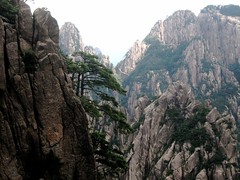
After a warmup walk from the bus dropoff to the base of the gondola, we were whisked up the mountain in the Swiss made contraption. My first impression was that Huangshan was that it was very similar to Huashan. Smooth granite rock in jagged formations with lots of tortured trees. Some of the obvious differences were that Huangshan is not near a plain or a river - were the air around Huashan not so hazy when we visited I'm sure the view of the countryside surrounding Huashan would have been quite interesting. In Huangshan you are in mountain range and get to see beautiful mountains instead of distant plains and cities.
Huangshan seems to be one of those places that is kind of a natural and spiritual place to visit. A place where you go to marvel at the beauty but also to identify with the shared identity of your country. Perhaps similar to the way that Americans view Grand Canyon - not just as an incredibly big and beautiful ditch but as a cultural icon, a place that represents the rugged beauty, individualism, self-reliance, and isolation of the west - a place where you wouldn't feel out of place wearing a cowboy hat even if you've never done so in your life.
One of the things that make it difficult to enjoy Huangshan is the number of tourists, mostly Chinese, who throng the central areas. There are quite a few tourists who are all vying to see the famous peaks and trees, most of which foreigners haven't heard of. We stopped by the Welcome Tree, a pine that has one horizontal bow that could be seen as an arm inviting visitors in. We had heard back in Tai Hu that this tree had died but were happy to see that it was still healthy. Turned out that another famous and old tree had kicked the bucket instead.
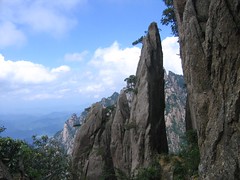
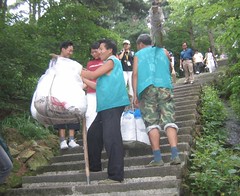
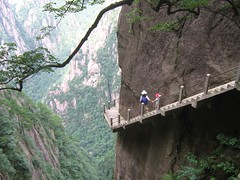
As we followed this difficult side trail we saw the most incredible scenery. Incredibly sharp peaks and twisted Bonsai trees that were very beautiful. I realized that all those painting I had seen were not exagerations but based on reality albeit an unlikely reality. The path seemed to go on forever so we consulted the map to see if turning back made more sense. Little did we realize the map was not scale and had not indication of how long each trail was. We decided to continue along the trail to make it a loop since the remaining distance didn't look too long. A fateful decision that our legs and especially John's calves regretted. Emily was quite energetic and managed to walk the whole way through what can be described as the ultimate Stairmaster experience. We felt a sense of urgency since we knew that the last tramcar to the base of the mountain left at either 5 or 6. Fortunately our heroic effort ended well and we ended up at the tram.
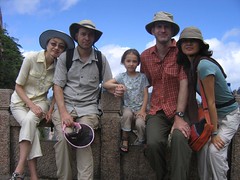
Huangshan is definitely one of the top sites to see in China. Some advice to those who haven't seen it yet. Plan ahead. Know the opening and closing times, the first and last tram car times, book hotels ahead of time, know where to obtain food. Stay there a few days so you can relax. One days is too little. Stay in the hotel at the top for multiple reasons: the convenience of avoiding the hectic shuttle up and down the mountain and to nearby towns, the summit is pleasantly cool in the summertime while the base of the mountain is scorching hot, the evening and early morning are quieter since most tourists have left. Take the sides trails since they're very scenic and are less crowded. Practive climbing hills, mountains, and stairs ahead of time since it is a very strenuous place to walk.
All Huangshan photos.
Tunxi and Yixian | 屯溪 . 黟县
We caught a taxi to Tunxi, the gateway town to Huangshan, after descending the mountain and enjoyed a scenic ride through the countryside. Our taxi driver stopped at a gas station to pick up his young daughter and to hand the taxi over to his partner. Most taxis it seems are driven by a couple of drivers. When one finishes his or her shift, the other takes over. At the gas station the driver indicated that apparently ethanol is a major fuel in Anhui province. Perhaps this was why air pollution didn't seem to be so bad there as in Beijing or nearby Shanghai.
Once we arrived in Tunxi there was a frantic scramble while John and Rong figured out (actually more like Gui and Rong) how to get back to Beijing to catch their flight back to Seattle. They booked a flight at the local airport and were on their way to Beijing.
Gui and I tried out a budget hotel right next to the train station. Unfortunately, we were low on cash and needed to find a bank machine. However, rather than drag our luggage all around town we wanted checkin first. The hotel concierge was not happy about checking us in and having us pay later which was frustrating considering that we were quite tired. However, Rong had lent us her bank card and we were able to get things settled. This was perhaps the closest experience I had to understanding what its like to have the financial resources of an average Chinese. For a few moments I imagined what it would be like if I didn't have a magic bank card and access to funds back in NA.
[Editor's notes]: What happened was that the county where the village was located has some millitary installations, as a result any foreigners entering the county needs a special permit from the local police. It was around noon when we started and the driver told us that police is on lunch break so we'd have to wait around for an hour or so, and he propsed to take us to a nearby "ancient fort" or some such thing which looks completely new. So we negociated to go somewhere more interesting --
a park near Huangshan that was famous becuase the Crouching Tiger Hidden Dragon scene where the sword, Green Destiny, is thrown into a sparkling pool. The weather at the park, as everywhere else that day, was scorching hot so we headed straight for the cafe to grab an iced treat. We walked by all the beautiful pools and marvelled at how scenic they were. The only thing we wished for was that the water level would be high to see some of the waterfalls at their best.Walking around a little more I noticed some chalkboards which Gui translated for me. Apparently these were progress reports on villagers' applications for permits to have children. In China, the one child policy requires that you get a permit before having a child. Most people are restricted to having one kid although there are exceptions. What amazed me most was that this board was up there for all villagers and tourists to see (provided they read Chinese) and contained extremely personal information. In NA, people are very reluctant to give out any personal information including medical conditions and records, number of children, marital status, age, religion, even sex. Each piece of such information can be used against people and likely are used against them. There are laws to protect against discriminination but these aren't perfect. I was reminded of this secrecy when I returned home and my co-worker who is approaching 60 reminded his manager that he couldn't ask him if he has plans to retire. Apparently there's some kind of law against asking that to prevent age discrimination. Presence or absence of children or intention to have children is something that is guarded by many people especially women. In fact you can't ask such questions of people during a job interview. This is in contrast to many other countries around the world where private details are open game and are basic criteria for getting a job - for instance, young women who have not yet had a child are discriminated against for many positions since the employer knows there is high probability that they will go on maternity or quit the medium term.
One of the interesting things about Yixian is that the county that contains this village is a restricted county due to some kind of military presence. Gui mentioned something about a missile program. When we headed to the village I had to sign in and present my passport. Haven't experienced this before. Reminded me of the yellow sections of the roadmap of the US, those restricted places where the army and navy perform target practice exercises. I also thought of the tension that had occured before 911 with the US military jet being captured by the Chinese and the bombing of the Chinese embassy in Serbia. 911 and the subsequent crackdown on terrorists (and separatists) had smoothed over relations. But all governments have their secret plans and perceived enemies which will likely always be the case.
[Editor's notes]:Matthew forgot to mention that there's a really neat wonton cart on the old street -- a compact mobile business that consists of a wooden cabinet that carris all the utensils, stove and pot, and the master wonton chef who made your order on the spot, super quick. The wonton cart is 100 years old. And the wontons (a small bowl for 4 yuan) are yummy!
All Yixian and Tunxi photos.
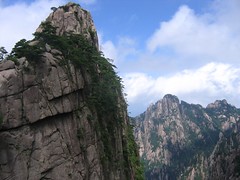

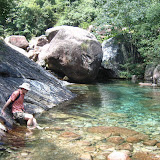
 China 2006 - Huangshan
China 2006 - Huangshan 